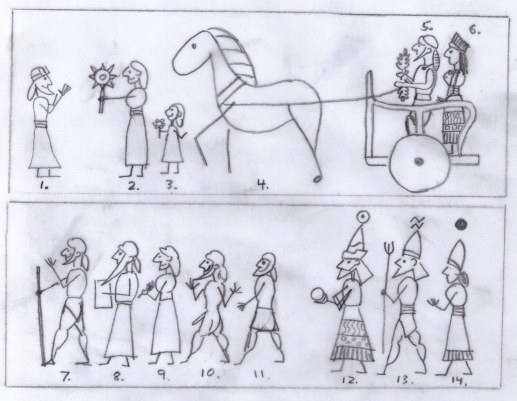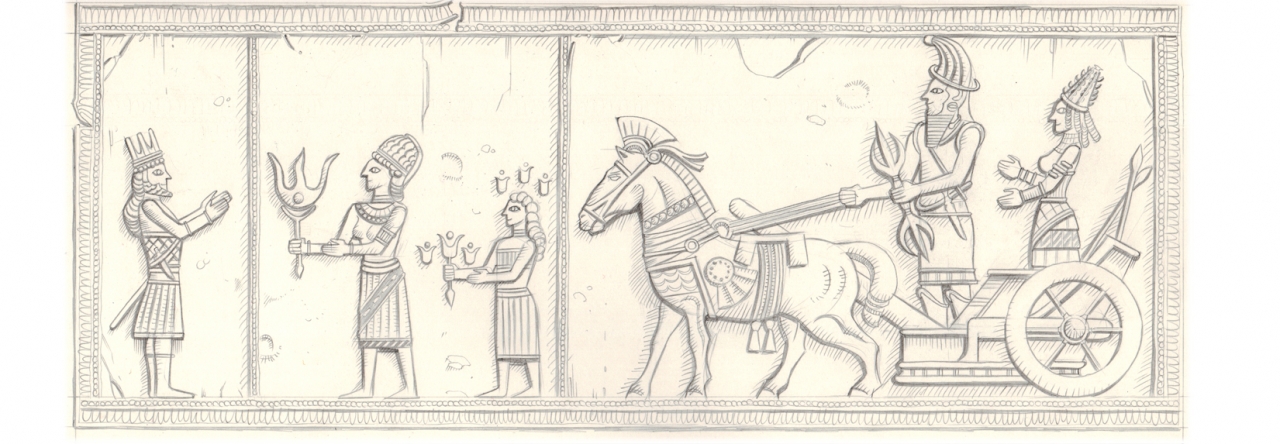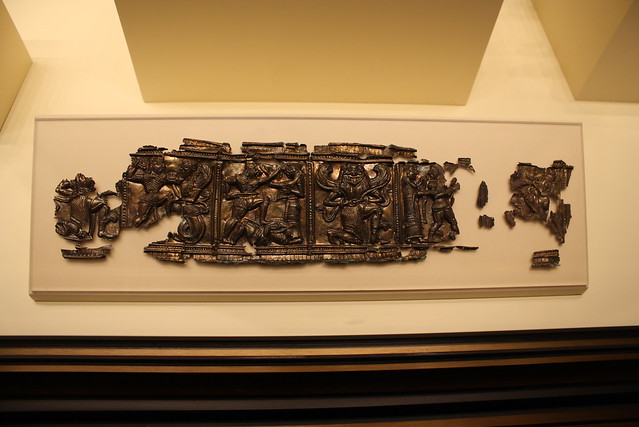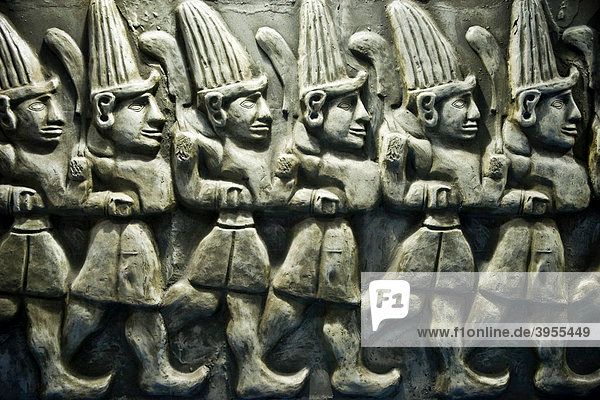Submitted by Jeff on Thu, 26/04/2012 – 10:27
There’s quite a bit of different Orlanthi art styles presented in the Guide (including Esrolian temple paintings, Sartarite coins, Vesmonstran enamels, and so on). They look much less “Viking” or “pseudo-Celtic” than previous books have presented, and much more late Bronze/early Iron Age. Part of this is a growing realization that the Orlanthi art and decoration have long been influenced by the wealthy Dara Happan culture (just as Archaic Greek styles were strongly influenced by that of Mesopotamia and Egypt), part of that is realizing that the Orlanthi have some pretty rich population centers of their own.
Anyways here’s a pair of silver-gilt plaques from the Holy Country, dating to the late Third Age. It shows the procession of the Theyalan gods at the Dawn.
Object: This is a pair of silver-gilt plaques
depicting mythological scenes in relief. It should be done in black and white, with shading to make it clear that this is the relief from a physical object. Like this:
Style: You get to invent a late Bronze Age/early Iron Age art style all of your own! This figures should be depicted with a combination of Archaic Greek style and Hittite relief. The figures are all facing left (except for figure Number 1, who faces right). The figures are stylized:
- Men all have beards, women have none.
- Eyes are large and almond-shaped
- The figures have an emotionless smile (the “Archaic smile”)
- Leg and arm muscles are shown stylistically
Here are some good examples of Archaic Greek relief:
- Two bronze helmets: http://www.metmuseum.org/toah/works-of-art/1989.281.49-.50
- http://www.southwestern.edu/departments/classics/images/athbirsh.gif (dead link)
- http://www.southwestern.edu/departments/classics/images/herathes.gif (dead link)
- http://www.sikyon.com/sicyon/images/adrastos.jpg (dead link)
Much of the clothing is not Greek at all, and should look more Hittite or Minoan or Mycanean. Here’s some examples of what I mean:
- http://cappadocialodge.com/yazilikaya.gif (dead link)
First Panel:

Fig. 1: King of Mortals greets the gods. This figure is the King of all Mortals (actually just the local ruler), who is welcoming the returned gods in supplication. He wears a three-pronged crown that looks like the Mastery Rune:
Fig. 2: Goddess of the Dawn carries the Flame of Light. The Dawn Goddess carries the Flame of the Sun and presents it to mortals. She wears a skirt, no shirt, and her hair is coiled. Something like the Canaanite goddess Astarte: http://upload.wikimedia.org/wikipedia/commons/d/dd/Astarte_Ashtart.png (dead Link)
Fig. 3: Goddess of Spring. This young child-goddess represents the first Spring. She carries flowers and has more flowers in her hair.
Fig. 4: Sun Horse: This is the divine Sun Stallion that pulls the chariot of the King and Queen of the Gods.
Fig. 5: Storm King. The King of the Gods holds the reins of the Sun Stallion in his left hand and carries the mighty Thunderbolt in his right hand, like this:
- http://pics.livejournal.com/richaje/pic/00060yfb
- http://pics.livejournal.com/richaje/pic/00061wgt
- http://www.ikigaiway.com/wp-content/uploads/2011/02/vajra.jpg
The Storm King wears armor (greaves and a cuirass) and a neck torc. He should be the biggest god depicted.
Fig. 6. Earth Queen. The Queen of the Gods stands next to her husband. She is beautiful, has intricate braids, and wears a high ornate crown. She wears a vest that exposes her breasts, like the Minoans:
and an ornate skirt with patterns. She wears lots of jewelry: bracelets, anklets, and most obviously, a great golden necklace (like Freya’s “Brísingamen”).
Second Panel:
Fig. 7: God of Communication. This god carries a long walking staff and traveling clothes. He might wear a broad hat if that looks good.
Fig. 8: God of Knowledge. This god has a very long bear and carries a tablet or a book. He wears a long robe.
Fig. 9: Goddess of Healing. This goddess wears a simple white robe and carries some healing herbs or medicine.
Fig. 10: Trickster God. This lewd god is naked, with a semi-erect phallus and an obscene grin (like a Greek Satyr:
Fig. 11: Grandfather Mortal. This god is the ancestor of mankind. He’s the least impressive of the goddess.

Fig. 12: The Sun Emperor. The defeated Emperor of the Sun now follows the Storm King. He has a tall crowned hat (like a Babylonian king), and a long and ornate robe. He carries an Orb of Rulership, and on top of his crowned hat is the Sky Rune:

Fig. 13: The Water Emperor. The defeated Emperor of the Oceans now follows the Storm King. He has a tall hat (like a Hittite god) and wears only a skirt. He carries a skinny trident and on top of his hat is the Water Rune:

Fig. 14: The Darkness Empress. The defeated Empress of Darkness now follows the Storm King. She wears an ornate skirt that should have dark patterns on it. Her hair is obviously dark. On top of her tall hat is the Darkness Rune:



The final version shows up in the Guide.
Submitted by Daniel Adamov on Fri, 27/04/2012 – 16:40.
I would imagine that the Holy Country styles would be quite different from Sartarite or Vesmonstran styles – even if they do influence each other, and share the common mark of Dara Happan influence. I certainly wouldn’t wish to lose those charming Sartarite woodcuts, though I suppose this may also have to do with the difference between rustic, rural old religious art and the art in big city temples.
Celtic or pseudo-Viking are still useful shorthands when it comes to introducing people to Orlanthi for the first time – and in truth I’d say they do have those influences along with many others, or so it seems to me. Still, I have no complaints about the Mycenean direction. It seems to fit their physical appearance and southerly location.
Anyhow, I’m really enjoying the surge of great art that we’ve been seeing here recently! I particularly like the Mastery rune crown. I wonder if we will get Kralorela or Teshnos at some point – I must admit I’m curious as to how you would approach those.
Submitted by Jeff on Fri, 27/04/2012 – 01:12.
Well first and foremost is Esrolia, which is Orlanthi (even if it is matriarchal), has almost 2 million people, and has one of the largest, most vibrant cities in the world. Esrolia casts a huge artistic influence over the rest of the Holy Country, Dragon Pass, and Maniria (and possibly even on Safelster).
Saird is a hybrid of Dara Happan and Orlanthi, with tremendous influence on South Peloria and Dragon Pass.
Vesmonstran is another. It numbers over 1 million Orlanthi, has access to dwarf crafting and Safelstran scholarship.
And so on.
Editor-in-Chief, Moon Design Publications
Submitted by davecake on Thu, 26/04/2012 – 22:47.
Great stuff, MD clearly has attracted some excellent artist talent.
Glad the artist did not, in fact, draw the knowledge god with a very long bear. Long bear is looooooonnnng!
Submitted by Bryan Chavez on Thu, 26/04/2012 – 21:33.
The art for the Guide to Glorantha is looking fantastic. I love the divergence from most of the previous illustrations of the Orlanthi – I always felt that one of Glorantha’s strongest features was taking much of its elements from ‘non-standard’ sources, that aren’t explored in most other Western fantasy settings. So I definitely like seeing that in the group that are often unfairly stereotyped into ‘Inland Fantasy Vikings’.
I really appreciate getting all of these updates. I hope you’re able to keep it up, because I both enjoy having a steady stream of information to keep me from getting too anxious with anticipation, and really like seeing all of the thoughts that went into the process of creating the book.
Submitted by Eric Vanel on Thu, 26/04/2012 – 18:01.
That’s wonderful and promising !
Who’s the artist ?
Do you plan as well the long awaited God’s Wall from GRoY ?
Submitted by Herve on Thu, 26/04/2012 – 16:35.
Wow. That is quite a departure from traditional orlanthi depictions. Guess some of them were much more influenced by the solar empire than we thought. What are those “pretty rich urban centers” of the orlanthi you refer to ?




